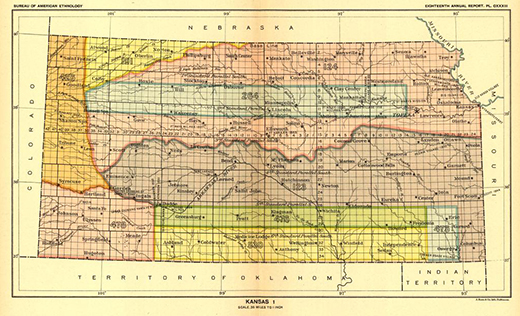A $150K NEH grant will help teach the Indigenous history of the land that helped create K-State
Wednesday, April 10, 2024

The Kansas Land Treaties Project, a digital resource for learning how Kansas went from the ancestral homeland of Indigenous nations to a state within the United States, will eventually present the multiple land cession treaties between the Kanza, now Kaw Nation, and the U.S. government. | Download this photo.
MANHATTAN — The National Endowment for the Humanities is supporting Kansas State University's Land Treaties Project to produce educational materials that tell the history of Kansas's land acquisition and the removal of the Kaw Nation.
The $150,000 Humanities Initiatives grant will help the Chapman Center for Rural Studies, in K-State's College of Arts and Sciences, and collaborators create oral histories, annotated historical documents, educational videos, curricula and other materials that demonstrate how Kansas — and particularly Kansas State University, the United States' first operational land grant institution — came to possess the land of the Kaánze níkashinga, whose descendants are the Kanza people today known as the Kaw Nation.
The project is led by Lisa Tatonetti, professor of English and Coffman Chair for University Distinguished Teaching Scholars; Tai Edwards, director of the Kansas Studies Institute; Mary Kohn, director of the Chapman Center; and Alex Red Corn, associate professor of educational leadership, executive director of the Kansas Association for Native American Education and co-chair of K-State's Indigenous Faculty and Staff Alliance.
"We are grateful for the opportunity this grant affords us to share this important history and promote essential understanding about Indigenous peoples and histories within our university and region," said Tatonetti. "Today, few students know that most of Kansas, including its name, was taken from the Kanza people before they were forced out of their ancestral homelands in Kansas and into Oklahoma in 1873. The Land Treaties Project brings multiple partners together to fill this knowledge gap."
Members of the Kaw Nation are collaborating on the project, including Vice Chair of the Kaw Nation James Pepper Henry and C. Huffman, a citizen of the Kaw Nation and Potawatomi descendent. Other collaborators include the Kansas Studies Institute, Johnson County Community College, regional high school educators and students from across the state.
"This project has been an extremely valuable project both for K-State and teaching and learning broadly across the state of Kansas," said Red Corn. "These histories are often layered and complex, making it difficult for educators to decipher the histories, geographies and politics endured by one of the most prominent Indigenous nations from this state."
The project's focus on engaged learning, connection and community supports the Next-Gen K-State strategic plan. Educational materials from this project are expected to reach thousands of students during the grant period, first focusing on K-State and Johnson County Community College. The materials and documentaries will be freely available to the public and are anticipated to be appreciated broadly throughout the region.
"This is an important step in making Indigenous peoples and nations more visible in our educational systems," said Red Corn. "Considering that the Kaw, or Kanza, peoples' name is all over our institutions, the least we can do is teach these fundamental histories."
More information about the Kansas Land Treaties Project is at kansastreaties.com, a digital resource that will eventually present the 1825, 1846, and 1859/1862 land cession treaties between the Kanza, now Kaw Nation, and the U.S. government.
Seed funding for this project came from Humanities Kansas, the Kansas Studies Institute and K-State's College of Arts and Sciences.
